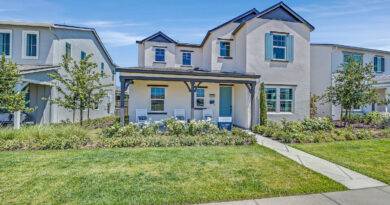The B&D Interview: Josh Santos, Northern California Division President, Landsea Homes
Homebuilding professional discusses his company’s design process, homebuyer preferences and next steps
Builder and Developer: Tell us about Landsea Homes’ design team’s process. How do they go about designing plans, elevations, etc.?
Josh Santos: Landsea has had quite a bit of evolution. We’ve been operating since the company was formed in 2013, and I joined the team in 2017 in Northern California. When we first started, we were an autonomous division, we were just NorCal-SoCal. Since then, we’ve grown to add divisions in Arizona, Texas, Florida and New York. And so the design process has evolved as well.
In the past, we relied heavily on consultants because we didn’t have a huge team at the time, but it has now evolved into a much more collaborative process. Divisions are working to lead design in their respective markets because we’re the experts of our locale. We still work with corporate in assembling the catalog.
We’ve been in the process of building a national architecture catalog as a reference for people who are going to do, say, a more urban infill project or high-density project where we can discuss a project we built in the past that either did really well or not so well and take that feedback to use as inspiration.
But, design is driven very locally. As we build our thesis, looking at a new opportunity, we ask, “do we have internal knowledge of that micro market?” Because we’re either currently operating there, we’ve operated recently or we’re networked with other builders that are operating in that market in addition to consultants and architecture firms that we work with. It’s to understand what is successful, having our reconnaissance with prospective buyers in that market as to what they’re looking for. Then we have our ideas and visions of what we want to build and execute. But at the end of the day, we have to work with the local jurisdiction to get approval to build them, and at times they offer some very significant influence as to what they want.
It’s a push and pull process, where we’re trying to balance something that’s interesting aesthetically, very functional within the form factor of what somebody’s gonna live in, then gaining the support for the outside aesthetic that the city wants to see in their jurisdiction. Then also what buyers want to see, and if we can do this in an economical place that makes financial sense to build it.
It’s a lot of back and forth with various stakeholders with a few people on the Landsea side taking the lead. As Division President for the Northern California Division, my background in homebuilding has been through sales and marketing, I feel relatively attuned to what buyers and the general market like, along with our Vice President of Sales and Marketing. Then we have our Vice President of Architecture working directly with our architecture firms to assemble trends from that group.
It takes time. We’ll start with a concept, we’ll shop to the local jurisdiction to ensure we’re going down the right path, get some feedback from those stakeholders, which can be planning commissioners, and then outside stakeholders; we’ll work with brokers, active brokers and real estate brokers because they’ve got a good pulse on what the buyer pool likes and wants. We’ll then start to develop and charrette those plans both from an exterior elevation side to the interior floorplans, getting a lot of that out and onto paper.
The architecture firms that we work with that are responsible for the actual design of the homes or the mechanics of designing the homes using their CAD (computer-aided design) systems, will hold up in a conference room for half a day to go through plans together. Then going through the plans with their lead architect and lead CAD operator in the digital space, we’ll make changes to maximize livability and buyer wants, which has evolved a lot recently with work-from-home opportunities and multi-generational families. And that’s where it starts.
Once we have something that we feel good about, we’ll go back to the jurisdiction and run it by them, making sure that we haven’t changed or manipulated something that they don’t like. Then we’ll start to work on the logistical side, pulling in our trades, our lead framer, lead plumber, lead electrician and lead mechanical engineer and look at plans through a buildability standpoint. We’ll get feedback from these trades and go back and make some slight adjustments to factor that in. This is to make sure that what we build is achievable, both physically and financially.
B&D: How do buyer preferences weigh in on the design process?
JS: Buyer preferences really tend to be weighted more towards the interior than the exterior. We tend to have more collaboration on the exterior side elevation with the local jurisdiction’s planning departments. Most of the buyer feedback that we harvest, either through study groups or through active communities in the region, is really focused on the utility of the home: how many bedrooms and bathrooms; how many different spaces are available for the various activities that the homeowner is going to have in their home; whether it’s a first-time homebuyer that’s buying their first one bedroom townhome; or a young family purchasing their first single-family detached home. We listen to not only the prospective buyers in the market, getting that information through our sales force engaging with prospective buyers, but also existing homeowners.
[Design is] a push and pull process, where we’re trying to balance something that’s interesting aesthetically, very functional within the form factor of what somebody’s gonna live in, then gaining the support for the outside aesthetic that the city wants to see in their jurisdiction.”
We survey our homeowners quite a bit within that first year of homeownership to get feedback on the process, the amenities and the features, and ask about the specific home that the homeowner bought. We take that information and harvest as much information as we can: what are the things that people love; what’s working well; what isn’t? We then put that information into a database that we can reference ongoing. This is so that when it comes time to either refresh a product line in geography or we think we’re going to enter a new geography, based on the information collected, we could take a product line that we’ve built nearby and look at the responses we got from our homeowners to see if there’s something that we can improve to better the product for the next time we build it.
B&D: What are your thoughts on the 2024 housing market thus far?
JS: Thus far, it’s been great. We’re always trying to forecast what the market is going to do. And so far this year, it has exceeded our expectations. Last year was a challenging year, with the interest rate spikes, we had to work on solutions to help buyers keep their motivation to buy a home with elevated interest rates through a lot of financing incentives and purchasing, and special rates.
When we were doing our forecasting for this year, at the end of last year, we expected to see the same. Towards the end of last year, we saw a nice reduction in interest rates, and it started to soften. So when we came into the new year, there was an increased vigor from our prospective buyers to get back into the market upon those softening rates.
As we finished off the last week of February, we did see rates kind of creep back up again. I think it might be a little bit of a yo-yo year in that there may be some opportunities when rates can come down. This year we’re very focused on getting home started so that when these opportunities come up, we have an available inventory of homes that somebody can jump into and lock in a good interest rate and close 30 or 60 days later.
B&D: What’s next for Landsea Homes?
JS: Landsea Homes in Northern California has been working very hard on some entitlements. We’ve got a large, 500-home master plan that will be coming to Dublin that we’re very excited about. It has a mix of low-density and high-density housing plus retail and commercial components.
Landsea Homes operates a high-performance home platform(HPH), and we’re looking to enhance this platform this year with strategic relationships with some manufacturers and suppliers. For instance, we’ve aligned with Apple, having signed an exclusive marketing agreement to include their Apple HomeKit for home automation. That is the foundation of other technologies that we’ll be announcing strategic alliances with, that includes products that can be controlled by the Apple HomeKit.
One of the four pillars of our HPH platform is Health and Wellness. This year we have a really big focus on that pillar. Some of the features that we are going to include in our homes are to promote a healthy lifestyle, asking ourselves, “What are some of the things that we can do when we build the home, and what features we can include that can make living in the home healthier? Hygiene for occupants, for example, whether that’s the ease of cleaning surfaces or one of the technologies that we’re very focused on in making standard in our homes are smart toilets. It’s a subject that the United States is behind on with some of the countries that many of our homebuyers originate from, like Japan or China and even Europe, having smart toilets and bidets, with cleaning features. If you live with a multi-generational family that has elderly folks living in the home, it offers a lot more convenience for that occupant because of the self-cleaning toilet itself and the automatic raising of the toilet seat cover.




